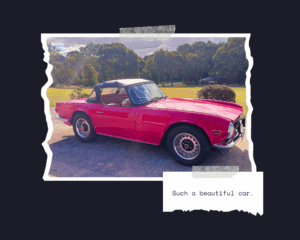
The arrival of the TR6
I have Dad to thank for my love of small fast cars. In 1983 he drove a signal red 1969 Triumph 6 into our driveway and I exclaimed, “Is this really ours?” The TR6 was not in good shape, but I adored her anyway. Dad spent more years and money than I would care to count down in the garage restoring her to mint glory. He bought every TR6 manual he could find to learn how to bring her engine back to life, he poured over history books recording the history of this unique car and found the right people to work on her when he needed different kinds of expertise. I loved the time I spent with Dad in the TR6—Sunday morning Scuderia club runs out to Learmonth, sprint days at Winton, and sunny afternoons on country roads with the top rolled down. Dad’s mantra was “There is no point driving a fast car slow” and so he didn’t. The TR6 really hits her stride at around 120km/h—the throaty growl of acceleration soon becomes a silken hum, rubber and road in perfect harmony. Back then the thrill of the ride filled me with exhilaration, and that sense of freedom to be found behind the wheel of a small fast car resonates loudly still.
Rolling over, racing on
“She meant to savour each turn of her traveling, loving the road and the trees and the houses and the small ugly towns, teasing herself with the notion that she might take it into her head to stop just anywhere and never leave again…I might never leave the road at all, but just hurry on and on until the wheels of the car were worn to nothing and she had come to the end of the world”—Shirley Jackson, The Haunting of Hill House [1]Shirley Jackson, The Haunting of Hill House, p. 17.
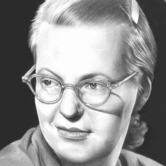
Shirley Jackson
A gothic, subversive, and unnervingly elegant writer.[2]Photo by Denise Nestor, in “Haunted womanhood” by Heather Havrilesky, The Atlantic, October, 2016.
“Eleanor’s little car stumbled and bounced, reluctant to go farther into these unattractive hills…the car cracked against a rock and reeled back across the road with an ominous scraping somewhere beneath…the car cleared a tangle of dead leaves and small branches across the road.”[3]Shirley Jackson, The Haunting of Hill House, 1959, p. 27.


In the late 1980s, Dad acquired another small car—an electric blue Superbug VW—which had been imported from Italy by a client who was unable to cover the costs of the required modifications for use on Australian roads. On the verge of being licensed to drive, “Bluey” was given to me and although not anywhere near as fast as the TR6, she too was not just a ride but an experience and loaded with personality. Bluey and I went over to Adelaide together when I started my first year of university and she ticked and clattered me to and from orchestra rehearsals, up and down to the Barossa, and around the Bay. Unlike the TR6, Bluey’s short wheelbase and rear weight distribution decreased her stability and increased her risk of rollover. I found out about this design trade-off the hard way when at the end of my first year at college, I woke to find myself and four friends upside down in Bluey resting against a tree on the banks of the Torrens. We had grabbed some takeout from the local fish and chip shop and decided to take a cruise around town. As we turned a bend in the river road, one of Bluey’s tyres blew out, and over and over we went. The news footage showed a crumpled structure of motion with pillars crushed, roofline flattened, and undercarriage exposed. I am not sure if it were The Fates or Fortuna who sat close by that night, but somehow, we were all pulled out alive more or less in one piece. Given the trauma of Bluey’s rollover, it is not surprising that the next car Dad bought for me was a 1978 Leyland Mini, yellow with black racing stripes.[4]To Dad, a life without car ownership was no life at all; having a car wasn’t just about convenience—it was about independence, freedom, and being prepared for whatever life threw your way. From … Continue reading We immediately named her “Tiger” and in true mini fashion, she hugged corners like it was on rails thanks to her low center of gravity, short wheelbase, and sport-tuned suspension—Tiger was much more likely to dance than roll, and so we did. With my hands holding her wheel tightly, me and this tiny little car sped as fast as we could east to west, south to north and back again for more than 15 years.[5]There is so much more to say about Tiger—about how Dad flipped his lid when a work colleague fitted a radio, the problem being it wasn’t a 1978 mini original and the fit out ruined the dash; … Continue reading Tiger was more than deeply satisfying, it was exhilarating—there is a sense of heightened velocity which comes from being in a confined space so close to the road, and once you feel that speed, you can’t unfeel it. Stereotypes might call this kind of thrill-seeking unfeminine, but I’ve never been one to follow the rules—give me a small car and an open road, and I’ll floor it every time.
“What is the brake used for?”[6]Photo by June Mirken Mintz, in Devers, A. (2016, December 14). The great American housewife writer: A Shirley Jackson primer. Longreads. … Continue reading
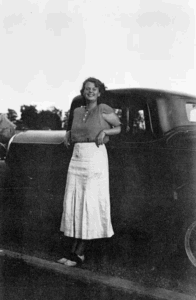
“With her carton on the back seat and her suitcase on the floor, her gloves and pocketbook and light coat on the seat beside her, the car belonged entirely to her, a little contained world all her own; I am really going she thought.”[7]Shirley Jackson, The Haunting of Hill House, 1959, pp. 15-16.
Can you imagine my delight when I discovered that Shirley Jackson had a fascination with driving small cars fast too? Oh, she was practical enough and drove family cars when she had to, but her real love was Morris Minor convertibles. Alongside a steadily increasing number of women, in 1950 Shirley took driving lessons every day for two weeks from a professional instructor called Eric,[8]Shirley Jackson, The Letters of Shirley Jackson, 2021, p. 167. did beautifully on her test. She drove through traffic and stop lights. She made a u-turn and started on a hill. She parked marvelously and drove slowly past dogs. She avoided hitting a little boy who ran out in front of her, remembered to go easy on the clutch and easily answered silly questions such as “What is the brake used for?”
She still didn’t know how to turn on the head lights or how to back up to the gas pump, but with a license to drive and a newly purchased 1940 two-tone Buick, she could go anywhere. License Plate Connecticut 47, the registration certificate for the car had her name on it and Shirley felt an odd thrill, a little like a child about to step into a wading pool for the first time, owning a vehicle all her own. The two-tone was the kind of middle-aged family car that everyone else in her county drove,[9]Shirley Jackson, The Letters of Shirley Jackson, 2021, p. 169. and for Shirley, fitting in was important. She would use the car to drive her husband Stanley to the train station, the children to the beach and to bring the groceries home—just like everyone else.
It would take some time after the Buick arrived for Shirley to purchase her first Morris Minor. In April 1955, she wrote to her “dearest mother and pop” with great excitement—a new foreign car agency had opened in Bennington and her husband Stanley suggested she should buy a tiny car from them for the millions of odds and ends trips she made each day—besides, it would be more fun in a fancy little car, easier to drive and much cheaper too. Shirley had grown tired of the two-tone station wagon and Stanley said that since the car was entirely hers, she could do as she pleased about the colour—but wouldn’t she prefer something more modest, a dark blue?[10]Shirley Jackson, The Letters of Shirley Jackson, 2021, p. 282. It was a classic Shirley moment: the freedom to choose, immediately followed by a gentle nudge toward the “right” choice. The irony wasn’t lost on her—permission wrapped in persuasion—and it only strengthened her resolve. A pink Morris Minor it would be. Her son Laurie protested, swearing he’d never set foot in a pink car, but Shirley was undeterred. She would write one story and pay for it herself.
Shirley never did get her fancy little pink car but in 1958 bought a black Morris Minor convertible with a red top and white wall tires. “Morris” was so much more than a set of wheels to get her from A to B—the car was her companion, her true delight and they were inseparable. She loved that children stared at her and “Morris” as they went zipping by up to the college parking lot to do figure eights![11]Shirley Jackson, The Letters of Shirley Jackson, 2021, p. 385. loved that Morris “giggled” when they drove.[12]Shirley Jackson, The Letters of Shirley Jackson, 2021, p. 425. She loved that Morris wandered beautifully and was prone to spontaneity; “There’s a road, let’s take that” Morris would suggest, and she went along madly. She loved that they “took off” on the most wonderful vacations staying in inns and telling stories and still managed to get home on time.[13]Shirley Jackson, The Letters of Shirley Jackson, 2021, p. 426. In 1962, Shirley bought herself another Morris Minor convertible, a white one this time. Her brave little cars never failed her, they were the “pride and joy of her life,”(Ruth Franklin, Shirley Jackson: A Rather Haunted Life, 2016, p. 418.)) and she kept them both—of course. When the money from the movie rights to The Haunting of Hill House came in, Shirley briefly entertained the idea of buying an Austin Healey convertible—a glamorous indulgence that seemed to match the moment. But as soon as she settled into the driver’s seat, it became clear: she wasn’t quite the “sports-car type”—she couldn’t even reach the pedals! For Shirley, her “Morris” was perfect—she revved its engine and drove fast, took turns at full speed and the thrill of “sailing along in my little car” never left her.[14]Ruth Franklin, Shirley Jackson: A Rather Haunted Life, 2016, p. 419.

“The signs still carried fragments of words. DARE, one of them read, and another, EVIL, and she laughed at herself, perceiving how she sought out omens everywhere; the word is DAREDEVIL, Eleanor, daredevil drivers, and she slowed her car because she was driving too fast and might reach Hill House too soon.”[15]Shirley Jackson, The Haunting of Hill House 1959, p. 19.
Driving fast: It’s a woman’s business too
Behind the wheel of her tiny Morris, Shirley Jackson defied all convention and transformed herself into a lady of speed; be damned all those naysayers who insisted she slow down, it was freedom she wanted and freedom she found! It was her I thought of when I purchased my new racing red Mini Cooper S in 2023 and so “Shirley” she became. I can’t imagine what it would have been like to be a woman who loved to drive fast during the first half of the twentieth century, not only facing the stereotype that it was men who sat in the driver’s seat while they were relegated to the passenger side but also the misguided opinion that “Driving is a man’s business. Women shouldn’t get soiled by machinery” or worse, the derogatory slurs about women being terrible drivers (a controlling tactic, some have argued, to ensure that women stayed at home where they belong).
There is a perception of masculinity associated with motoring that is undeniable and remains unchallenged.[16]Brown, M. (2024, December 15). Many more men are dying on Australian roads than women. It’s time we addressed it. The Conversation. … Continue reading Many pejorative stereotypes about female drivers continue to spread their misogynistic wings and fly out of mouths today, even though statistics tell a very different story about the skill and safety of drivers by gender. Research tells us that in Australia, men die more often in car accidents and suffer serious injury, take more risks than women behind the wheel, and are more likely to drink drive. I don’t know about you, but I think it’s time to retire these out-of-warranty stereotypes about women drivers and upgrade to a more accurate, roadworthy narrative that reflects historical and contemporary lived experience. So, let me introduce you to Joan Margaret Richmond, on record as Australia’s first professional racing car driver.
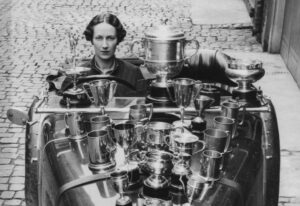
Joan Richmond: An impressive trophy display on the bonnet of her 1921 3-litre G.P. Ballot racer, 1936
Born in 1905 on a dusty station near Cooma, she was raised on horsepower—first the kind with hooves, then the kind with pistons. Told she couldn’t race as a jockey, she pivoted to cars, declaring that “cars had all the say” and vowing to own one “by hook or by crook.”[17]All of the quotes from Joan Richmond are taken from the following interview: Melbourne Girls and Their Hobbies MONSIEUR TINTIN’S WATCH (1930, September 4). Table Talk (Melbourne, Vic. : 1885 … Continue reading She did just that, buying a Baby Citroën and driving it 2,500 km with her mother across Australia’s wild heart. In garages where women were barely tolerated, she taught herself to mend punctures, grind valves and reline brakes, and entered every race she could. “There is no greater thrill in the world than speeding!” she declared, and the world began to take notice. With fresh-coloured skin and wavy brown hair, she was dubbed “the jolly girl” who loved cars for their “innards.” In 1931, she became the first woman with Mollie Shaw by her side to compete in the Australian Grand Prix, finishing fifth. That same year, she joined fellow trailblazers Kathleen Howell and Jean Robertson[18]Once you start looking, there are women like Joan Richmond everywhere in Australia’s motorsport history. The 2015 article by Judith Glover and Harriet Edquist “Women in the Australian automotive … Continue reading on a 20,000-mile journey from Melbourne to Monaco, racing in the Monte Carlo Rally with cars named The Bellbird, The Wattle Bird, and The Kookaburra.[19] See the Sun News-Pictorial, 1st July, 1931. In 1932, she and Elsie “Bill” Wisdom[20]Elsie “Bill” Wisdom was a trailblazer in British motorsport, known for her fearless driving and fierce determination. Nicknamed “Bill” by her brothers, she broke into racing in the 1920s and … Continue reading won the 1,000-Mile Race at Brooklands, earning her the title “the coolest and calmest of modern young women speedsters.” Fame followed—“just too famous I am,” she wrote—but so did scrutiny. After her win, she joked that all she wanted was “a face massage, plucked eyebrows, a manicure, and a hair wave, and to get the rest of the grime off.” And imagine my delight in discovering that in 1934, she drove a Triumph open tourer in the Royal Scottish Automobile Club Rally, finishing 15th out of 59. She didn’t just drive—she drove change. Her life was a masterclass in daring and decorum, grit and glamour, and her legacy as Australia’s first professional female race car driver still roars.
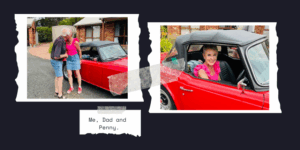
““because the little morris was beginning to be kind of shaky i went down to the car store a few days before we left and bought a brand new mg sedan, bright red, and we took it on the trip; that was the nicest thing of all, because although the car is officially a sedan it is really a sports car, and drives like one. on those long flat midwestern roads i had a wonderful time.”[21]This excerpt is taken from Shirley Jackson’s last letter to her parents—Gerald and Leslie Jackson—written on 12th May, 1965, and opened with her usual “dearest mother and pop” (The Letters … Continue reading
Wheels in motion, in memory of Dad
Father’s Day in Australia falls on the first Sunday in September. This year in memory of Dad and desperately trying to be jolly, this girl turned the key, revved the engine, and took Penny—my affectionate name for the TR6—for a spin. The sky above Brisbane was picture perfect blue, the kind Dad loved and lived for. As Penny and me climbed Mount Coot-tha, I imagined him beside me—“Don’t ride the clutch,” he’d say, “Keep your gear changes clean.” So, I did. In a moment reminiscent of the iconic acceleration in the final scene from Thelma and Louise (1961),[22]The final scene in Thelma and Louise is more dramatic than my Sunday drive. After pausing at the edge of a cliff, Thelma and Louise reach to hold one another’s hand and then drive their white 1966 … Continue reading pressed my foot down, executed downshifts and upshifts as smoothly as I could, took the corners as fast I dared, and smiled as the TR6 giggled.
In that moment, I wasn’t just driving. I was remembering. I was resisting. I was rewriting the rules in my own way, on my own terms. I was Shirley Jackson, defying domesticity in a giggling Morris Minor, choosing pink when told to pick a more sensible blue, sailing along in a little red car that dared to dream. I was Joan Richmond, Australia’s first lady of speed, racing through history in a Triumph, cool, calm, and covered in grit and glory. And I was me—a woman who loves small fast cars, who finds freedom in velocity, who tells stories through motion. Women like me, we are fast, we are roadworthy, we are not parked, we are not passengers—we have a license to drive, and we are not slowing down.
References
| ↑1 | Shirley Jackson, The Haunting of Hill House, p. 17. |
|---|---|
| ↑2 | Photo by Denise Nestor, in “Haunted womanhood” by Heather Havrilesky, The Atlantic, October, 2016. |
| ↑3 | Shirley Jackson, The Haunting of Hill House, 1959, p. 27. |
| ↑4 | To Dad, a life without car ownership was no life at all; having a car wasn’t just about convenience—it was about independence, freedom, and being prepared for whatever life threw your way. From the moment each of us was legally allowed to get behind the wheel, he made sure we had our own set of keys—whether it was by purchase, through part payment or the provision of advice. It was a rite of passage, and he took great pride in making it happen. My older sister Sally’s first car was a red 4-door Datsun Sunny 1200, which she loved—until she rolled it the same year that I lost control in Bluey. What a year that must have been for our parents! We both walked away with several bruises and lessons learnt, but Dad never made us feel foolish. He just wanted us to be safe and supported. When it came time for my younger sister Natalie to get her first car, Dad wasn’t taking any chances. He helped her choose a Chilli red (yes, there is a colour theme going on here, because red really does go faster) Ford Focus sports model, packed with all the latest safety features. She still drives it today, and I think Dad slept better knowing she was behind the wheel of something solid and secure—especially given the track record of her older sisters. His generosity didn’t stop with us. When each of his grandchildren got their probationary licenses, Dad paid half the cost of each of their first cars. It was his way of passing on the same sense of freedom and responsibility he’d given us. And it wasn’t just about the purchase—he was always there in person or by phone for the breakdowns and the unexpected repairs. Whether it was a quick fix or a major job, Dad was the one we called. |
| ↑5 | There is so much more to say about Tiger—about how Dad flipped his lid when a work colleague fitted a radio, the problem being it wasn’t a 1978 mini original and the fit out ruined the dash; about how I drove her down with friends to a shack by the Murray River and had to haul her out of the mud; about how I woke up numerous mornings at college to find Tiger uplifted and placed between two trees; about how I managed to put Max in and out of a car seat in Tiger and how he loved her too (the photo attests to this!); and, about how sad we both were when we realised that putting two children in a three door mini was no longer practical. I would give anything to have Tiger back, and I am constantly scouring the pages of vintage car seller magazines hoping to find one just like her. |
| ↑6 | Photo by June Mirken Mintz, in Devers, A. (2016, December 14). The great American housewife writer: A Shirley Jackson primer. Longreads. https://longreads.com/2016/12/14/the-great-american-housewife-writer-a-shirley-jackson-primer/ |
| ↑7 | Shirley Jackson, The Haunting of Hill House, 1959, pp. 15-16. |
| ↑8 | Shirley Jackson, The Letters of Shirley Jackson, 2021, p. 167. |
| ↑9 | Shirley Jackson, The Letters of Shirley Jackson, 2021, p. 169. |
| ↑10 | Shirley Jackson, The Letters of Shirley Jackson, 2021, p. 282. |
| ↑11 | Shirley Jackson, The Letters of Shirley Jackson, 2021, p. 385. |
| ↑12 | Shirley Jackson, The Letters of Shirley Jackson, 2021, p. 425. |
| ↑13 | Shirley Jackson, The Letters of Shirley Jackson, 2021, p. 426. |
| ↑14 | Ruth Franklin, Shirley Jackson: A Rather Haunted Life, 2016, p. 419. |
| ↑15 | Shirley Jackson, The Haunting of Hill House 1959, p. 19. |
| ↑16 | Brown, M. (2024, December 15). Many more men are dying on Australian roads than women. It’s time we addressed it. The Conversation. https://theconversation.com/many-more-men-are-dying-on-australian-roads-than-women-its-time-we-addressed-it-243477 |
| ↑17 | All of the quotes from Joan Richmond are taken from the following interview: Melbourne Girls and Their Hobbies MONSIEUR TINTIN’S WATCH (1930, September 4). Table Talk (Melbourne, Vic. : 1885 – 1939), p. 26. Retrieved October 2, 2025, from http://nla.gov.au/nla.news-article146454157 |
| ↑18 | Once you start looking, there are women like Joan Richmond everywhere in Australia’s motorsport history. The 2015 article by Judith Glover and Harriet Edquist “Women in the Australian automotive industry: A survey” is a great read and much of the material included here is drawn from their work. In an era when the open road was considered no place for women, Kathleen Howell and Jean Robertson revved their engines and proved otherwise. These two daring friends, graduates of Clyde School in Melbourne, were not content with the genteel expectations of their time. Instead, they chose grit over glamour, speed over silence, and the thrill of the unknown over the safety of convention. Their adventures were not mere joyrides—they were acts of resistance. In 1927, they drove from Melbourne to Darwin, navigating deserts and bushland with nothing but a Lancia Lambda, strips of coconut matting for traction, and the mechanical wisdom passed down by another trailblazer: Alison Anderson. Anderson, who ran Australia’s first all-female motor garage, taught them how to maintain and repair their vehicle—skills that were as radical as they were practical in a world that doubted women’s competence under the bonnet. Together, Kathleen and Jean became the first women to drive across Australia and later attempted to break the Fremantle to Sydney land-speed record. They weren’t just racing time—they were racing patriarchy. Their success in dependability trials and 24-hour reliability races earned them respect in the motoring community, but more importantly, they carved out space for women in a domain that had long excluded them. These women didn’t just drive—they drove change. Their story is a reminder that feminism isn’t always loud; sometimes, it hums beneath the hood of a car, roars across red earth, and leaves a trail of dust where barriers once stood. |
| ↑19 | See the Sun News-Pictorial, 1st July, 1931. |
| ↑20 | Elsie “Bill” Wisdom was a trailblazer in British motorsport, known for her fearless driving and fierce determination. Nicknamed “Bill” by her brothers, she broke into racing in the 1920s and quickly made history—most famously winning the 1932 JCC 1000 Mile Race with Joan Richmond, the first all-female team to do so. She raced at Le Mans, tackled the Monte Carlo Rally, and became the first woman on Aston Martin’s works team. Wisdom’s legacy lives on through her daughter Ann, also a motorsport pioneer. |
| ↑21 | This excerpt is taken from Shirley Jackson’s last letter to her parents—Gerald and Leslie Jackson—written on 12th May, 1965, and opened with her usual “dearest mother and pop” (The Letters of Shirley Jackson, 2021, p. 594). Like all her letters to them, it was typed entirely in lowercase, “usually single-spaced, most done with total avoidance of the shift key” (p. xiii). Her son and editor of Shirley’s collected letters, Laurence Jackson Hyman (2021, p. xiii) notes that her habit was to write mostly everything in this format, reflecting her personality perfectly: a mix of dry wit, breezy charm, and occasional frustration. She tapped them out on her old manual typewriter whom she affectionately named “ernest” (p. xiv), letting her thoughts flow in a kind of casual, stream-of-consciousness rhythm which became part of her signature style. |
| ↑22 | The final scene in Thelma and Louise is more dramatic than my Sunday drive. After pausing at the edge of a cliff, Thelma and Louise reach to hold one another’s hand and then drive their white 1966 Ford Thunderbird convertible off the edge of the Grand Canyon. With her hands on the wheel, Louise returns their capacity as women to choose for themselves, their defiant leap symbolising at once a tragic and liberating escape from patriarchy. To conclude this piece, I almost included the following quote from the final scene in The Haunting of Hill House—“With what she perceived as quick cleverness she pressed her foot down hard on the accelerator…I am really doing it, she thought, turning the wheel to send the car directly at the great tree at the curve of driveway.” But, while we might view Thelma and Louise’s leap a radical act of feminist self-authorship, Eleanor’s fatal crash marks a tragic surrender to internalised repression and psychological confinement—no, I decided, that would not do as a concluding epigraph at all |